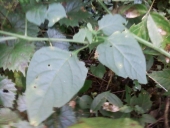Here is a link to a permies thread that addresses solanum nigrum and a few similar plants.
In my location, the plants i have identified are fully edible. I have made a black nightshade jelly, eaten the steamed leaves, and eaten the berries raw without any ill effects.
As is mentioned in that thread lisutsa is the common name in Kenya for the leaf of black nightshade.
@heather
Yeah you have a good point about the myths of poison when we are talking about highly domestic species. A tomato now and its leaves are usually not analogous to a tomoto written about in the 1800s. Just as lettuce was considered medicinal and in fact it was back before it had been completely domesticated into what we see today.
@lorenzo
I have learned to be weary of people who are completely sure about things, especially things as complicated as nature. Was your teacher thinking of deadly nightshade? Are some s. Nigrums strong enough to be poison? Was the teachers experience with eating the berries unripe? You never can be sure when there are so many conflicting views.
With all plants i would say do your own research and identification until you feel totally comfortable that what you have is an edible species. Before i ate my black nightshades i became a tomb of information about the plants uses around the world and throughout history. Even after i had a complete id and background i still eased my way into eating it. Just as the kenyans do, i can eat a whole portion of s nigrum leaVes with a meal and feel only positive effects.











